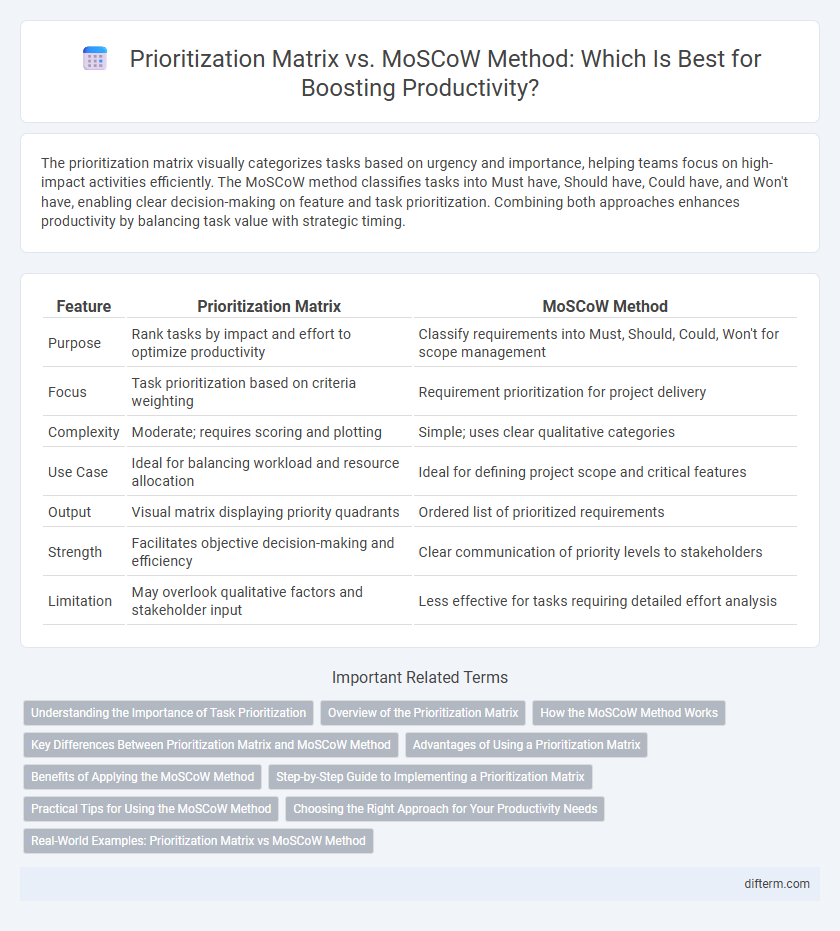The prioritization matrix visually categorizes tasks based on urgency and importance, helping teams focus on high-impact activities efficiently. The MoSCoW method classifies tasks into Must have, Should have, Could have, and Won't have, enabling clear decision-making on feature and task prioritization. Combining both approaches enhances productivity by balancing task value with strategic timing.
Table of Comparison
| Feature | Prioritization Matrix | MoSCoW Method |
|---|---|---|
| Purpose | Rank tasks by impact and effort to optimize productivity | Classify requirements into Must, Should, Could, Won't for scope management |
| Focus | Task prioritization based on criteria weighting | Requirement prioritization for project delivery |
| Complexity | Moderate; requires scoring and plotting | Simple; uses clear qualitative categories |
| Use Case | Ideal for balancing workload and resource allocation | Ideal for defining project scope and critical features |
| Output | Visual matrix displaying priority quadrants | Ordered list of prioritized requirements |
| Strength | Facilitates objective decision-making and efficiency | Clear communication of priority levels to stakeholders |
| Limitation | May overlook qualitative factors and stakeholder input | Less effective for tasks requiring detailed effort analysis |
Understanding the Importance of Task Prioritization
The Prioritization Matrix offers a clear visual framework by categorizing tasks based on impact and effort, enabling teams to focus on high-value activities effectively. MoSCoW method structures priorities into Must-have, Should-have, Could-have, and Won't-have, facilitating stakeholder alignment and balanced resource allocation. Understanding the importance of task prioritization improves productivity by ensuring critical tasks receive immediate attention while less urgent tasks are scheduled appropriately.
Overview of the Prioritization Matrix
The Prioritization Matrix is a decision-making tool that helps teams evaluate tasks based on multiple criteria such as impact and effort, enabling more objective prioritization. It visually categorizes activities into quadrants, typically distinguishing high-impact, low-effort tasks from those less critical or more resource-intensive. This approach streamlines focus on tasks that maximize productivity while minimizing wasted effort, improving project efficiency and goal alignment.
How the MoSCoW Method Works
The MoSCoW method structures project tasks into four categories: Must have, Should have, Could have, and Won't have, enabling clear prioritization based on criticality and resource availability. This approach helps teams concentrate on delivering essential features first, ensuring project success even with limited time or budget. By categorizing requirements, stakeholders gain clarity on what drives value and what can be deferred, improving decision-making and productivity.
Key Differences Between Prioritization Matrix and MoSCoW Method
The prioritization matrix organizes tasks based on impact and effort, enabling quick visualization of high-value activities, while the MoSCoW method categorizes tasks into Must-have, Should-have, Could-have, and Won't-have, focusing on stakeholder requirements and project scope. Prioritization matrices emphasize task efficiency and resource allocation, whereas MoSCoW prioritizes feature importance and delivery sequencing in product development. This fundamental difference reflects the matrix's use in operational task management versus MoSCoW's application in agile project prioritization.
Advantages of Using a Prioritization Matrix
A prioritization matrix offers a clear visual framework to evaluate tasks based on multiple criteria such as impact and effort, enabling more objective decision-making. This method helps teams identify high-value actions quickly, improving focus and resource allocation. Compared to the MoSCoW method, the prioritization matrix reduces ambiguity by quantifying priorities, which enhances productivity and project efficiency.
Benefits of Applying the MoSCoW Method
Applying the MoSCoW method enhances productivity by clearly categorizing tasks into Must, Should, Could, and Won't haves, ensuring critical activities receive focused attention. This approach improves decision-making efficiency and resource allocation, reducing time spent on less impactful tasks. Teams benefit from increased clarity and alignment on project priorities, driving faster and more effective outcomes.
Step-by-Step Guide to Implementing a Prioritization Matrix
The prioritization matrix streamlines task management by evaluating items based on impact and effort, allowing teams to focus on high-value activities efficiently. Start by listing all tasks, then score each on predefined criteria like urgency and importance to plot them in a four-quadrant matrix. This clear visualization guides resource allocation and decision-making, enhancing overall productivity compared to the MoSCoW method's categorical prioritization.
Practical Tips for Using the MoSCoW Method
When applying the MoSCoW method, clearly categorize tasks into Must have, Should have, Could have, and Won't have to enhance decision-making efficiency. Use this prioritization matrix to allocate resources effectively, ensuring critical features receive immediate attention while less urgent tasks are scheduled appropriately. Regularly revisit and adjust the prioritization as project requirements evolve to maintain alignment with business goals and deadlines.
Choosing the Right Approach for Your Productivity Needs
Selecting between the Prioritization Matrix and the MoSCoW method depends on project complexity and team preferences. The Prioritization Matrix excels in visualizing task urgency and impact, enabling effective decision-making for resource allocation. The MoSCoW method categorizes tasks into Must, Should, Could, and Won't, simplifying stakeholder communication and ensuring alignment on essential deliverables.
Real-World Examples: Prioritization Matrix vs MoSCoW Method
The Prioritization Matrix is widely used in project management at companies like Microsoft to categorize tasks based on impact and effort, enabling teams to focus on high-value activities. In contrast, the MoSCoW method is favored by agile development teams at firms like Spotify, where requirements are classified as Must-have, Should-have, Could-have, and Won't-have to guide iterative delivery. Real-world applications show the Prioritization Matrix excels in resource allocation for complex projects, while MoSCoW enhances clarity and flexibility in evolving product backlogs.
Prioritization matrix vs MoSCoW method Infographic

 difterm.com
difterm.com